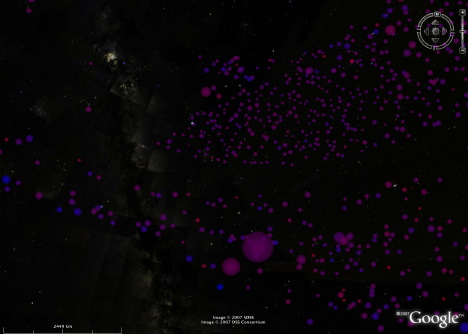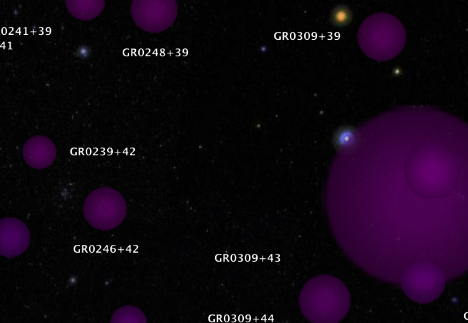After a series of posts documenting the process of converting the contents of the Ukraine Russia Radio Telescope Database into KML, L. Van Warren posts the results (Direct link to the KML file for the impatient). And it sure is pretty: The locations in the sky of 1855 prominent radio sources, including 118 quasars, with relative radio brigtnesses depicted by circle size:


It’s fun to go see if a particular source also has a visual component — it isn’t always the case.
So why was Van’s task so Herculean? Because the raw data looked like this:

It takes quite a bit of regex gymnastics to turn the above into KML that looks like this:

The Ukraine Russia Radio Telescope Database is not the only place where data is available online but in a format unfriendly to machines. The Aerith site, which houses a wealth of ephemeris data on comets, has a similar handicap. Click through to an individual comet to see the orbital data in a space-delimited format, with the actual positions generated for you in a graphic.
This is how astronomical data has often been shared in the past, but not how it will be shared in the future. There is a better way: XML.
This is not a new idea. We’ve already run into the Virtual Observatory Event (VOEvent) XML specification, and over on Astronomy Blog, Stuart is working on an XML schema that would allow telescopes to have “an RSS-like XML feed” showing what’s been viewed and when. Oh Inverted World blog gets it immediately:
There are a myriad of benefits to such an approach, the main one being that it will be easier to collaborate globally on projects, particularly those which can be aided by numerous observations and ancilliary data.
What’s changed recently is that there is now an astrobrowser, Google Sky, that is can understand and render XML. KML descriptions of astronomical objects are now a simple XSL transformation away from any other XML format, such as VOEvent XML or Stuart’s XML. As a consequence, the incentive to provide machine-readable astronomical metadata instead of text tables just got a lot stronger. There’s no more need to peer at static charts — just load the data in Google Sky, and mash it up with anything else you like.
In an ideal world all such observational astronomical data would exist in a machine-readable markup format, and I’m willing to venture it soon will. Just as it took the geospatial web a year or two to re-orient itself towards making its data available in a format compatible with KML, the astronomical web will take a while to provide its data in a similar format.
But I have little doubt that in the very near future, you’ll be able to download position data for all new comets as KML, which in turn has been generated on demand, perhaps as a network link, from ephemeris data provided as an RSS feed. And who will come up with the astronomical equivalent of Panoramio, where amateur astronomers can upload time-stamped comet imagery? Imagine being able to chart the progress of a bright comet in Google Sky over the course of a month by playing in quick succession the accumulated contributions of hundreds of amateur astronomers. I can’t wait to see it:-)
I was actually the one that noticed this layer and asked L. Van Warren to submit it to the community. I think layers like these are making googlesky a tool useful for more than just amateurs and, honestly, I really think it’s GREAT!
This is, of course, what we intended to do with Sky all along! All kinds of communities can share information and browse astronomical archives both for legacy data and newly acquired information! It is great to see this explosive growth.
A very interesting post and a good summary of the current situation with machine-readable data in astronomy. Thanks for mentioning my post on the subject. I particularly like the ideas presented in the final paragraph – getting live feeds on new brightening comets would be fantastic.
the KML link is broken! help!